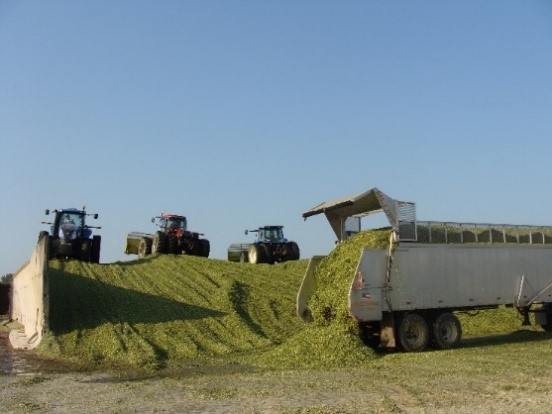
Kevin Jarek, Liz Binversie, Bill Halfman, Paul Mitchell
This tool helps a farmer calculate the tons of silage in bunker silos and convert it to its grain equivalent for including in 2019 production for determining CFAP payments.
Begin by downloading the Bunker Silo Volume spreadsheet: https://fyi.extension.wisc.edu/forage/files/2020/01/BunkerSiloVolume-English-Spanish-French-Protected.xlsx.
Step 1: Enter the various bunker measurements in the yellow cells.
- For a partially fed bunker, enter 0 for the ramp that has been removed and use the Wall Length on January 15, 2020.
- See the short video explaining the logic of these measurements: https://youtu.be/19K6mEVA5TE.
- The default Dry Matter Density is 14 lbs/ft3. Use this spreadsheet to develop your own estimate: https://fyi.extension.wisc.edu/forage/files/2020/01/BunkDensCalc-English-Spanish-Russian-French-Welsh-Hungarian-Protected.xlsx.
Step 2: In the pink cells, read Dry Weight in Bunker as tons of DM.
Step 3: Divide Dry Weight in Bunker by 0.35 to convert silage tons of DM to 65% moisture.
Step 4: Multiply by the FSA conversion factor. Corn silage is 7.94 bu/ton (at 65% moisture) and 4.08 bu/ton (at 65% moisture) for oatlage.
Example: Determine the wet tons of 65% silage in a partially fed bunker silo.
- Wall height is 12 ft, average bunker width is 36 ft (halfway up the bunker wall), top width is 40 ft, the dome is 3 ft above the wall, there is no filling ramp (0 ft), the back ramp is 15 ft long and the wall length left on January 15 is 80 ft. Use the standard 14 lbs/ft3 dry matter density and 65% moisture.
- Spreadsheet calculates 310 Dry Weight in Bunker in the pink cell.
- Divide by 0.35 to convert to standard 65% moisture: 310/0.35 = 885.7 tons wet silage.
- Convert to grain equivalents using FSA conversion factors:
- Corn Silage: 886 x 7.94 bu/ton = 7,035 bu of Corn
- Oatlage: 886 x 4.08 bu/ton = 3,615 bu of Oats
- Soybean Silage: 886 x 5.00 bu/ton = 4,430 bu of Soybeans
- Grain Sorghum Silage 886 x 5.56 bu/ton = 4,926 bu of Sorghum
- The demonstration video explains the logic of these calculations starting at minute 16:41: https://youtu.be/0xusEej5JnI.
- The demonstration video explains the spreadsheet starting at minute 17:18: https://youtu.be/0xusEej5JnI.